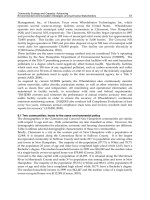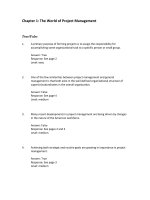Lecture Project management in practice - Chapter 3: Organisational strategy and project selection
Bạn đang xem bản rút gọn của tài liệu. Xem và tải ngay bản đầy đủ của tài liệu tại đây (662.22 KB, 28 trang )
CHAPTER 3
Organisational Strategy and
Project Selection
Copyright © 2013 McGraw-Hill Education (Australia) Pty Ltd
Pearson, Larson, Gray, Project Management in Practice, 1e
3-1
Learning Elements
3.1
Further develop and understand the
importance of the methods that define and
align an organisation’s project activity.
3.2
Understand the features of portfolio
management systems and the role of a
typical Project Management Office (PMO).
Copyright © 2013 McGraw-Hill Education (Australia) Pty Ltd
Pearson, Larson, Gray, Project Management in Practice, 1e
3-2
Learning Elements (cont)
3.3
Be able to identify what information and
support a PMO should be providing to
your project environment.
3.4
Understand the project manager’s
responsibilities in relation to supplying
information to a PMO.
Copyright © 2013 McGraw-Hill Education (Australia) Pty Ltd
Pearson, Larson, Gray, Project Management in Practice, 1e
3-3
Why Project Managers Need to
Understand Strategy
• Project managers must respond to
changes with appropriate decisions about
future projects and adjustments to current
projects.
• Project managers who understand their
organisation’s strategy can become
effective advocates of projects aligned
with the firm’s mission.
Copyright © 2013 McGraw-Hill Education (Australia) Pty Ltd
Pearson, Larson, Gray, Project Management in Practice, 1e
3-4
Common Mistakes
• Focusing on problems or solutions with low strategic
priority.
• Focusing on the immediate customer rather than the
whole market place and value chain.
• Overemphasising technology that results in projects
that do not fit the strategy or customer need.
• Trying to solve customer issues with a product or
service rather than focusing on the 20% with 80% of
the value.
• Engaging in a never-ending search for perfection only
the project team really cares about.
Copyright © 2013 McGraw-Hill Education (Australia) Pty Ltd
Pearson, Larson, Gray, Project Management in Practice, 1e
3-5
The Strategic Management
Process: An Overview
Copyright © 2013 McGraw-Hill Education (Australia) Pty Ltd
Pearson, Larson, Gray, Project Management in Practice, 1e
3-6
Key stages
1. Define and review the organisational mission,
vision and values.
2. Set the organisation’s strategic objectives.
3. Analyse the strategic objectives and identify
the ‘ideal’ investment mix.
4. Implement strategies through portfolios,
programs and projects.
Copyright © 2013 McGraw-Hill Education (Australia) Pty Ltd
Pearson, Larson, Gray, Project Management in Practice, 1e
3-7
Stage 1
efine and review the organisational mission,
vision and values
he mission identifies ‘what we want to
become’ or the raison d’être.
written mission statement provides
focus for decision making when shared
by organisational managers and
employees.
Copyright © 2013 McGraw-Hill Education (Australia) Pty Ltd
Pearson, Larson, Gray, Project Management in Practice, 1e
3-8
Stage 1 Tools
•
•
•
•
•
•
SWOT
PESTEL
Porter’s 5 Forces
Blue Ocean Strategy
Strategy Maps
Balanced Scorecard
Copyright © 2013 McGraw-Hill Education (Australia) Pty Ltd
Pearson, Larson, Gray, Project Management in Practice, 1e
2–9
3-9
Stage 2
et the organisation’s strategic objectives
trategic objectives translate the organisation’s
mission and vision into specific, concrete,
measurable terms. Strategic objectives set
targets for all levels of the organisation.
emember SMARTA!
Copyright © 2013 McGraw-Hill Education (Australia) Pty Ltd
Pearson, Larson, Gray, Project Management in Practice, 1e
3-10
Stage 2 (cont)
Copyright © 2013 McGraw-Hill Education (Australia) Pty Ltd
Pearson, Larson, Gray, Project Management in Practice, 1e
3-11
Stage 3
nalyse the strategic objectives and identify
the ‘ideal’ investment mix
he portfolio of investments identified in support
of the strategic objectives is a result of a
complex process.
his potentially involves business managers,
program managers and other subject-matter
experts.
Copyright © 2013 McGraw-Hill Education (Australia) Pty Ltd
Pearson, Larson, Gray, Project Management in Practice, 1e
3-12
Stage 3 (cont)
The business case includes:
• Strategic alignment criteria
• Definition of the business problem
• Benefits identification and analysis
• Options analysis, do-nothing option,
deferred option and three other options
• Business risk analysis
• Funding summary
• Milestone summary
Copyright © 2013 McGraw-Hill Education (Australia) Pty Ltd
Pearson, Larson, Gray, Project Management in Practice, 1e
3-13
Stage 4
mplement strategies through portfolios,
programs and projects
mplementation answers the question of how
strategies will be realised, given available
resources, equipment, change tolerance and
a host of other factors.
Copyright © 2013 McGraw-Hill Education (Australia) Pty Ltd
Pearson, Larson, Gray, Project Management in Practice, 1e
3-14
Stage 4 (cont)
These factors include:
1. Completing tasks requires allocation of
resources
2. Authority, responsibility and performance – the
organisation’s structure
3. Planning and control systems must be in place
4. Motivating project contributors will be a major
factor for achieving project success
5. Prioritising projects
Copyright © 2013 McGraw-Hill Education (Australia) Pty Ltd
Pearson, Larson, Gray, Project Management in Practice, 1e
3-15
The Need for an Effective
Portfolio Management System
Problems in implementing include:
• The implementation gap
• The organisation’s politics
• Resource conflicts and multitasking.
Copyright © 2013 McGraw-Hill Education (Australia) Pty Ltd
Pearson, Larson, Gray, Project Management in Practice, 1e
3-16
Benefits of Portfolio
Management Systems
Copyright © 2013 McGraw-Hill Education (Australia) Pty Ltd
Pearson, Larson, Gray, Project Management in Practice, 1e
3-17
A Portfolio Management System
Copyright © 2013 McGraw-Hill Education (Australia) Pty Ltd
Pearson, Larson, Gray, Project Management in Practice, 1e
3-18
Selection Criteria
Financial
• BCR
• NPV
• Payback
Non financial
• To make it difficult for competitors to enter
the market
• To develop an enabler product, which by its
introduction will increase sales in more
profitable products
Copyright © 2013 McGraw-Hill Education (Australia) Pty Ltd
Pearson, Larson, Gray, Project Management in Practice, 1e
3-19
Selection Criteria (cont.)
Checklist models
•The most frequently used method in selecting
projects has been the checklist.
•This approach basically uses a list of questions to
review potential projects and to determine their
acceptance or rejection.
Copyright © 2013 McGraw-Hill Education (Australia) Pty Ltd
Pearson, Larson, Gray, Project Management in Practice, 1e
3-20
Selection Criteria
(cont.)
ulti-weighted scoring models
weighted scoring model typically uses several
weighted selection criteria to evaluate project
proposals.
eighted scoring models will generally include
qualitative and/or quantitative criteria.
Copyright © 2013 McGraw-Hill Education (Australia) Pty Ltd
Pearson, Larson, Gray, Project Management in Practice, 1e
3-21
Multi-weighted
Scoring Models (cont.)
Copyright © 2013 McGraw-Hill Education (Australia) Pty Ltd
Pearson, Larson, Gray, Project Management in Practice, 1e
3-22
Selection Criteria (cont.)
• Pair-wise criterion (Analytic Hierarchy
Process)
• Nominal Group Technique (NGT)
Copyright © 2013 McGraw-Hill Education (Australia) Pty Ltd
Pearson, Larson, Gray, Project Management in Practice, 1e
3-23
Applying a Selection Model
Continued on next slide
Copyright © 2013 McGraw-Hill Education (Australia) Pty Ltd
Pearson, Larson, Gray, Project Management in Practice, 1e
3-24
Applying a Selection Model (cont)
Copyright © 2013 McGraw-Hill Education (Australia) Pty Ltd
Pearson, Larson, Gray, Project Management in Practice, 1e
3-25









